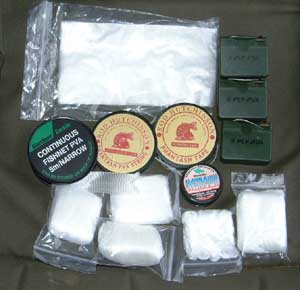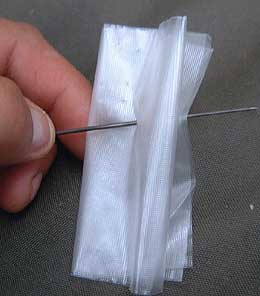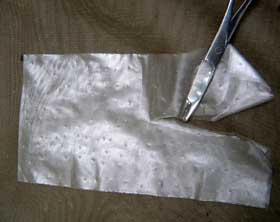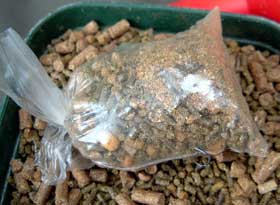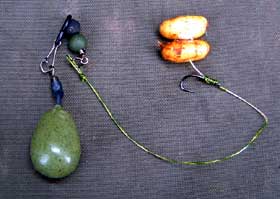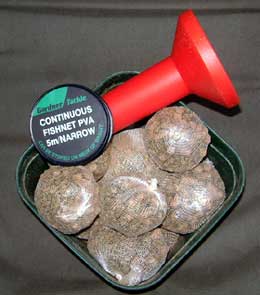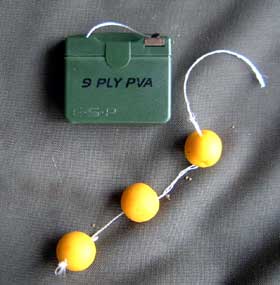| BIG RIK | |
| Rik started fishing at the age of four on his local tiny tidal river, catching eels and small wild trout on worm. Not having had any angling family members, all his early fishing was solitary and this seems to have carried through to the present. He currently lives in the depths of Hampshire, and so is within easy reach of some excellent venues. He has in the past, and still does, fish for most species, although his greatest love is for carp fishing, which is how the majority of his time is spent. He now finds himself more thrilled with overcoming the intricacies and problems associated with catching carp, rather than the actual weight of the fish he catches and the so-called glory that goes with it. |
| PVA has two basic forms, bags and string, and these can then be subset into various types. The bags come in solid or mesh forms and in various shapes and sizes. The string also comes in various types, different thicknesses, strengths and dissolve rates through to varying types of tape. ALL ABOUT PVA
The use of PVA is designed to distribute loose offerings in close proximity to the hookbait. This enables tight baiting on small feeding spots and areas.
There are other reasons for people to use PVA, one is to combat gulls that take loose feed in mid-air, another is to avoid tangles whilst casting, and a third is to enable you to present a clean bait over bottom debris. In the first part of this article I will concentrate on bags, as this is probably the most widely used form of PVA. Step by step guide I take my PVA bag and fold it into four, I then pierce the bag all over to perforate it, this will allow the bag to sink because a solid bag will contain air and may float for some time before dissolving. Occasionally I may not perforate the bag to such a degree and this will cause the bag to sink at a slower rate. I use this to nestle the bag on top of weed when I don’t want my hookbait in the thick of it. On other occasions I have put stones into the bag to speed up its descent through the water. As usual it means adapting the method to suit my personal circumstances and will depend on where the fish are, where and how they are feeding and where and how I would like to present my baits. After I’ve perforated the bag I cut down from the top opening to leave the depth I require for the bag. I then insert my feeding funnel and place a small, thin layer of food items into the base.
Next, I insert my hookbait into one corner of the bag and then either use a nugget of dissolving rig foam over the hook, or pierce the hook through the bag so that it finishes on the outside. This is because I do not want any of the free offerings in the bag to prick and mask the point of the hook. The funnel is re-inserted and the bag filled until it almost reaches the top of the cut. I then insert the lead into the top of the open bag and place it on the OPPOSITE side of the bag to that of the hookbait, because the lead is the heaviest item in the bag the whole package should fall through the water lead first. This means the lead will be at the bottom and your hookbait will be above it when the bag settles. What you don’t want is for your bait to be trapped under 3oz of lead. Next, I secure the top of the bag, using the two ties I created, by knotting them around the mainline/tubing. As the PVA is quite pliant and stretchable, you can tighten up the ties to make the bag quite solid and this will stop the bag from exploding in mid air due to the lead shifting. Now I trim off the tag ends from the ties and I am left with a solid, compact object that will cast well.
The contents of the bag can be many things I use various types of pellet that breakdown in different stages so that I have several forms of texture to hopefully entice any marauding fish. Sometimes I pour various liquids into the bags, these liquids must not be water based or they will melt the PVA. Certain oils and liquid food supplements will have a minimal water content and thus can be used in the bags if they are not left for too long.
I would advise that you test these out before attempting to use them, as wearing 3oz of almon oil as shampoo is not the best way to spend a Sunday afternoon. A quick comment at this point on rigs Most of the rigs I contain within bags tend to be a maximum of about 6″ long, a short rig in a confined feeding area will give an instant bolt effect and should produce a good, secure hookhold. Do not be misled into thinking that PVA bags must only be fished at distance. I quite often stalk fish with a PVA bag set-up, which enables me to present a clean hookbait and loose feed to a fish with minimal disturbance. How much splash does a PVA bag slowly lowered off the rod tip make? A lot less than throwing in a handful of bait and once again you have a near-perfect trap for that stalked fish. (That’s another edge I’ve lost).
For short range work it is possible to dispense with the tying, just twist the top of the bag, moisten your thumb and forefinger and grip the twisted bag tightly for about 5 or 10 seconds. This imparts just enough moisture for the PVA to stick onto itself and is fine for short-range work. In no circumstances should you use food bag ties, staples or other bizarre items to secure bags, other members of the angling fraternity that advocate this have probably never seen these accoutrements tangled on the end tackle to form tether rigs. Mesh bags
A lot of these mini bags filled with pellets and broken baits can be tied up in advance and kept in a dry, airtight bucket, and just nicked onto the hook when required. In this state they are also useful for catapulting out to your fishing area as loose feed. Loose feeding pellet at 60 yards without a spod – nice. Give them a spray to tighten them up PVA string and tape Attaching the PVA to your hook also gives you the extra benefit of added weight at the hook end of your terminal set up and a better chance of a tangle free cast. String is available in many guises This is where tape is much better, as its larger surface area means it melts easier.
Stringer Guidelines Also, be very careful when tying knots in PVA string as, in all but the highest water temperatures, these knots won’t melt. One of the commonest and possibly best way to use string is to place 3 or 4 baits on a length, about 1 1/2 to 2″ apart and nick the hook through the end of the PVA. This gives a tangle free presentation with free offerings close to the hook. The weakest link A thing to be aware of with PVA that may be old is that if it has come into contact with damp air then you may find that it becomes very tough indeed and, in all probability, may not melt at all. I hope this broad overview of PVA has given you an insight into how it is most commonly used and throughout my other articles I may make reference to its other uses. |










